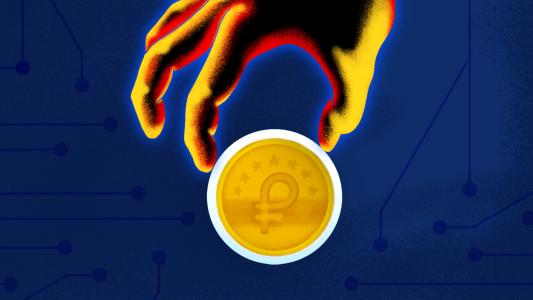This article is an installment of The Future Explored, a weekly guide to world-changing technology. You can get stories like this one straight to your inbox every Thursday morning by subscribing here.
Artist Michael Winkelmann, also known as Beeple, creates hilarious, thought-provoking, and sometimes vulgar images that often exist solely as pixels on a screen. As a digital artist, it can sometimes be tough to pay the bills.
But last December, Beeple sold $3.5 million worth of art in one weekend.
And he’s not the only artist to experience this windfall — digital artwork is a hot commodity right now. It’s being sold for millions of dollars thanks to a unique type of crypto asset, called non-fungible tokens (NFTs).
NFTs are creating a brand new, albeit speculative, marketplace for digital content. In a world where digital files are often thought of as cheap, proponents say this is a huge opportunity for digital creators to sell their own work.
What Is It?
NFTs represent digital collectibles on the blockchain. “Digital collectibles” may sound like an oxymoron since collectibles, by definition, need to be rare — and most “things” online aren’t rare because they can usually be duplicated or forged.
But these digital tokens act as a way of minting a piece of original content or collectible goods — usually digital animations, images, or videos, but NFTs can represent physical objects too.
NFTs act as an artist’s “digital signature” — much like Picasso’s signature can be used to verify the authenticity of his paintings.
The token is stored in blockchain technology — the same kind of decentralized ledger used by cryptocurrencies, like bitcoin.
Each token represents ownership of a specific item. NFTs also act as an artist’s “digital signature” which can be used to verify the origins of the item — much like Picasso’s signature can be used to verify the authenticity of his paintings. And because this crucial information is on the blockchain, it’s impossible to forge or counterfeit.
This blockchain verification, combined with the nonfungible characteristic of these tokens, creates scarcity in the marketplace.
Cryptocurrencies and traditional currencies (like the US dollar) are fungible — meaning, each piece of currency is interchangeable and can be subdivided into smaller fractions. For example, my $1 USD is worth the same as your $1 USD, and both of our dollars are worth 100 pennies.
This isn’t the case with NFTs. Since they are nonfungible, no two tokens are ever identical, and they cannot be subdivided.
“I use the example of a physical trading card,” Ryoma Ito, head of marketing at a crypto art marketplace called MakersPlace, told Forbes.
“They’re accessible by the millions, but when, say, Steph Curry comes along and autographs one of those cards it will increase the value as long as there’s a way to authenticate that signature. When a creator publishes to blockchain, they’re permanently associating their signature with that piece. It’s just a digital signature rather than a physical autograph.”
Smart Contracts
Since these tokens live on the blockchain (mostly, the Ethereum platform), they are backed by contracts that are written into the blockchain. Whatever terms the creator sets in the initial contract will be executed automatically. These contracts also automatically update to show the current owner of the NFT — each time a token changes hands, that exchange gets reflected in the contract.
This blockchain verification creates scarcity in the marketplace.
What’s more, these smart contracts can allow artists to see financial gains if their work appreciates in value over the years. This usually isn’t possible with traditional art collectibles — after the initial sale, the artist won’t financially benefit if their artwork suddenly becomes much more valuable in later years. But with a smart contract, digital artists can claim a certain percentage (usually between 2 and 10%) of each subsequent sale for years to come.
“NFTs are the single biggest reorientation of power and control back into the hands of the artist basically since the Renaissance and the printing press,” Robert Alice, a digital artist in London told Forbes. He’s also seen the financial benefits of NFTs.
“It appeals to people who have built up their own audiences — maybe on social media — to go and sell work directly to their audience.”
The sales usually happen on platforms like Nifty Gateway, Foundation, and SuperRare.
Why Buy an NFT?
Tokens symbolize ownership. But you can still download a piece of Beeple’s artwork from his social media or take a screenshot of it for free. So why shell out thousands of dollars for an NFT when you have no way to control the actual item itself?
While anyone can download or take a screenshot of the file, theoretically their copy won’t have the same value as the original backed by an NFT.
And for most collectors, ownership is the point — that’s why some NFT platforms act as a digital gallery where people can display their purchases for everyone to see.
“Anyone can see pictures on the internet of the most expensive artworks; posters are sold in museums,” Vincent Harrison, a New York gallerist told Wired.
“But it’s the ownership that creates value. So with NFTs, not only do you have ownership, you have ownership on the blockchain, you have ownership that is transparent for everyone to see.”
NFTs are revolutionizing other markets, too — any collectible items, such as sports trading cards, virtual sneakers, and even virtual real estate, can be represented by an NFT. The NBA even created token-backed collectible video clips that can be traded online.
Challenges
NFTs are new and exciting — but will they become the next big thing or go the way of Beanie Babies? It’s too early to say, but if NFTs are going to become mainstream, there’s still a lot of issues to work out.
For one, while content on the blockchain can still be subjected to “real world” copyright laws, it’s not super clear how those copyright issues will play out on the blockchain.
Another challenge could just be the temporary nature of the internet. The NFTs are stored on a blockchain, so they’re permanent. But the artwork itself? Most art is too large to be stored on a blockchain itself, according to Fortune. You wouldn’t want to be that person who owns millions of dollars of art only to have the artwork’s website go offline someday.
According to Fortune, however, there are some workarounds to this. Some artists are starting to use a decentralized internet called the Interplanetary File System (IPFS) to host their artwork. This system is similar to BitTorrent, in that the digital files are stored on many different computers around the world, instead of on one centralized server.
Perhaps even cooler is the fact that some artists are starting to create art that can be stored on the blockchain itself. For example, EulerBeats uses algorithms to produce music and images that can be stored on a blockchain.
We’d love to hear from you! If you have a comment about this article or if you have a tip for a future Freethink story, please email us at [email protected].






